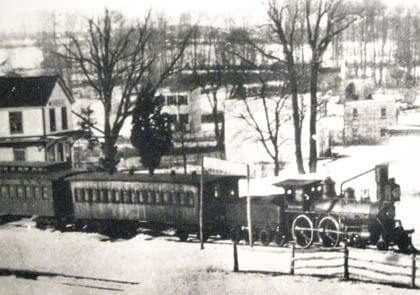By Philip Newman
In 1834, there were 23 states in the United States, Andrew Jackson was president, Britain abolished slavery and the Long Island Rail Road was born.
Dave Morrison, whose career was with the LIRR, put it another way 175 years after the founding of what would eventually become the nation’s busiest passenger railroad.
“Think of it: It was before the telephone, before airplanes, before automobiles, before electric lights, even before the telegraph,” he said.
The advent of the railroad brought apprehension. Would people fear to ride in a contraption that flew along at a speed 2 1⁄2 times that of a horse and buggy?
Morrison, a retired LIRR veteran, spoke proudly about working for the railroad and its march through history, dispensing a blizzard of statistics and dates on the link that transformed transportation between New York City and the outer reaches of Long Island far to the east.
The occasion was a preview of “The Route of the Dashing Commuter — The Long Island Rail road at 175,” an exhibit at the New York Transit Museum in Brooklyn.
Morrison, who loaned some of his memorabilia items to the exhibition, is familiar with his subject. Now retired, he was a branch line manager for the LIRR on the Oyster Bay, Port Jefferson and Montauk branches. He now represents the Long Island Rail Road Historical Society.
The Transit Museum displays vintage photographs, maps, illustrations and objects on loan from museums and private collections in telling the story of the railroad’s graduation from steam power to diesel and electric propulsion and how Long Island grew with the railroad, which still influences its development.
The exhibit also traces the LIRR’s sometimes troubled journey through financial difficulties and bankruptcy, its rehabilitation in the late 1960s under the administration of the late Gov. Nelson Rockefeller and its present era of ultra−modern equipment.
The original idea behind the LIRR and the railroads it absorbed was to cut travel time between the nation’s two largest cities, New York and Boston.
That was accomplished by establishing rail service to Greenport, on Long Island’s north shore, where passengers switched to a ferry to Stonington, Conn., and resumed their trips by train to Boston.
“When we were chartered in 1834, it is doubtful our founders envisioned what we would become 175 years later — the largest commuter railroad in North America serving 87.4 million customers on more than 700 miles of track stretching from Penn Station to Montauk and many communities in between,” said LIRR President Helena Williams.
“The decade to come will see continued efforts to modernize our operation as we get ready for the largest expansion of our service in recent times,” Williams said. “The East Side Access will provide LIRR customers with a one−seat ride to Grand Central Terminal, a key service improvement benefiting travelers for the next 175 years to come.
“We encourage all to make the trip to Brooklyn to see where it all began,” Williams said.
The exhibit runs from April 14 to Sept. 13 at the Transit Museum at Boerum Place and Schermerhorn Street in Brooklyn. Admission for adults is $5, children 3−17 $3 and seniors 62 and over $3. Admission for seniors is free on Wednesday.
For more information, call 718−694−1600.
Reach contributing writer Philip Newman by e−mail at news@timesledger.com or phone at 718−229−0300, Ext. 136.






























